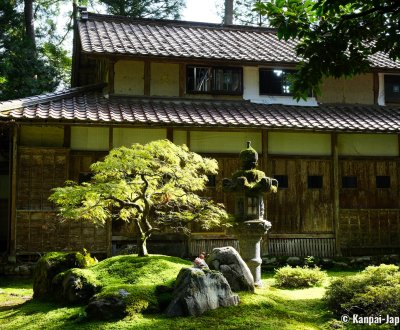Hiyo Koke no Sato
Moss Garden At Nata-Dera Temple
Hiyo Koke no Sato is a moss garden in Hiyo, a small village mountain affiliated to Komatsu City in Ishikawa prefecture in Japan. A small gem hidden in a large cedar forest at the entrance of Nata-dera temple, it offers a pleasant discovery, imbued with quietness and harmoniously blending in the surrounding nature.
Located in the mountains, mid-way between the cities of Kanazawa and Fukui, Hiyo is the perfect example of a satoyama, that is to say a typical Japanese rural mountain village. Protected by a huge cedar forest, Hiyo village is perched in the heights of Komatsu City, not far from Nata-dera temple in Ishikawa prefecture. The ubiquitous nature provides a green landscape, with a wealth of water, as well as wood that is used for building the houses, temples and shrines’ traditional architecture.
While less than a dozen households live there, they form a tight community involved in the preservation of their lifestyle in harmony with nature, in a place remote from the coastline’s neighboring cities. In 2013, a community project named Koke no Sato (the "moss village") was founded to show visitors the marvels of its unique territory.
As a matter of fact, Hiyo village benefits from natural conditions favorable to the development of forest moss (of the bryophytes group). These primitive miniature plants, essential to biodiversity, are thriving in the fresh, dark and humid environment of the cedar forest’ s undergrowth.

Moss village under great cedar trees
After leaving the car 🚙 at the parking, the forest opens like a true haven of peace and gives the impression of being alone in the world. The moss carpet spreads endlessly at the foot of the trees, decorated with cute porcelain statues of the most popular Japanese deities, such as the 7 Lucky Gods, or Billiken, a lucky mascot very popular in Osaka.
In Hiyo Koke no Sato, the inhabitants are growing and maintaining 48 different moss species. They display various textures: smooth, spiky or fluffy, and their colors change from plant to plant and under the influence of the weather: soft green in spring 🌸, to dark green in winter, through emerald green and orange yellow hues. The moss garden is even more beautiful after the rain ☔️.

Due to the importance of preserving this natural site, advices are displayed at the village’s entrance, especially:
- Do not eat or picnic outside;
- Do not walk on or touch the moss, use the pedestrian walkways for strolling around;
- Do not shout or speak too loud so as not to disturb the quiet environment of the people living here.
Note that it is possible to plan a guided tour in Japanese thanks to the moss garden’s volunteers.
The discovery of the village ends at its Shinto shrine, called Hiyo-jinja, where festivals and yearly traditional ceremonies take place. Its torii ⛩️ gates and its little pavilions perfectly blend into a marvelous scenery.

